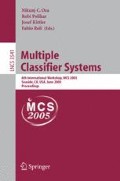Abstract
In this paper the Dempster-Shafer theory of evidence is utilised in multiple classifier systems to define rejection criteria for samples presented for classification. The DS theory offers the possibility to derive a measure of contradiction between the classifier decisions to be fused. Moreover, assigning positive belief mass to the universal hypothesis Θ in the basic probability assignments produced by the classifiers, allows to quantify the belief in their correctness. Both criteria have been evaluated by numerical simulations on two different benchmark data sets. The results are compared to standard static classifier combination schemes and basic classifiers. It is shown that DS classifier fusion can boost the combined classifier accuracy to 100% on the set of accepted data points (~ 70%). This behaviour could be of interest in applications with high costs for a miss, e.g. in medical screening tests.
Access this chapter
Tax calculation will be finalised at checkout
Purchases are for personal use only
Preview
Unable to display preview. Download preview PDF.
References
Pearl, J.: Probabilistic Reasoning in Intelligent Systems: Networks of Plausible Inference. Morgan Kaufmann, San Francisco (1988)
Dubois, D., Prade, H.: Combination of information in the framework of possibility theory. In: Abidi, M.A., Gonzalez, R.C. (eds.) Data Fusion in Robotics and Machine Intelligence, pp. 481–505. Academic Press, London (1992)
Zadeh, L.A.: Fuzzy sets. Information and Control 8, 338–353 (1965)
Zadeh, L.A.: Fuzzy sets as a basis for a theory of possibility. Fuzzy Sets and Systems 1, 3–28 (1978)
Kuncheva, L.I., Bezdek, J.C., Duin, R.P.W.: Decision templates for multiple classifier fusion: An experimental comparison. Pattern Recognition 34, 299–314 (2001)
Bloch, I.: Information combination operators for data fusion: A comparative review with classification. IEEE Transactions on Systems, Man and Cybernetics, Part A 26, 52–67 (1996)
Dempster, A.P.: A generalization of Bayesian inference. Journal of the Royal Statistical Society 30, 205–247 (1968)
Shafer, G.: A Mathematical Theory of Evidence. University Press, Princeton (1976)
Shafer, G.: Dempster-Shafer Theory (2002), http://www.glennshafer.com/assets/downloads/article48.pdf
Grzymala-Busse, J.W.: Managing Uncertainty in Expert Systems. Kluwer Academic Publishers, Boston (1991)
Pomykalski, J.J., Truszkowski, W.F., Brown, D.E.: Expert systems. In: Webster, J. (ed.) Wiley Encyclopedia of Electronic and Electrical Engineering (1999)
Rogova, G.: Combining the results of several neural network classifiers. Neural Networks 7, 777–781 (1994)
Xu, L., Krzyzak, A., Suen, C.Y.: Methods of combining multiple classifiers and their applications to handwriting recognition. IEEE Transactions on Systems, Man, and Cybernetics 22, 418–435 (1992)
Denoeux, T.: A Neural Network Classifier Based on Dempster-Shafer Theory. IEEE Transactions on Systems, Man and Cybernetics, Part A 30, 131–150 (2000)
Milisavljevic, N., Bloch, I.: Sensor fusion in anti-personnel mine detection using a two-level belief function model. IEEE Transactions on Systems, Man and Cybernetics, Part C 33, 269–283 (2003)
Smets, P.: Belief functions: The disjunctive rule of combination and the generalized Bayesian theorem. International Journal of Approximate Reasoning 9, 1–35 (1993)
Zadeh, L.A.: Book review: A mathematical theory of evidence. AI Magazine 5, 81–83 (1984)
Heinsohn, J., Socher-Ambrosius, R.: Wissensverarbeitung. Eine Einführung. Spektrum Akademischer Verlag (1999)
Smets, P.: The nature of the unnormalized beliefs encountered in the transferable belief model. In: Proceedings of the 8th Conference on Uncertainty in Artificial Intelligence, pp. 292–297. Morgan Kaufmann, San Mateo (1992)
Mandler, E., Schürmann, J.: Combining the classification results of independent classifiers based on the Dempster/Shafer theory of evidence. Pattern Recognition and Artificial Intelligence, 381–393 (1988)
Al-Ani, A., Deriche, M.: A new technique for combining multiple classifiers using the Dempster-Shafer theory of evidence. Journal of Artificial Intelligence Research 17, 333–361 (2002)
Le Hegarat-Mascle, S., Richard, D., Ottle, C.: Multi-scale data fusion using Dempster-Shafer evidence theory. Integrated Computer-Aided Engineering 10, 9–22 (2003)
Fay, R., Kaufmann, U., Schwenker, F., Palm, G.: Learning Object Recognition in a NeuroBotic System. In: Groß, H.M., Debes, K., Böhme, H.J. (eds.) 3rd Workshop on SelfOrganization of AdaptiVE Behavior SOAVE 2004, Fortschritt-Berichte VDI, Reihe, VDI, vol. 743(10), pp. 198–209 (2004)
Gonzales, R.C., Woods, R.E.: Digital Image Processing, 2nd edn. Addison-Wesley, Reading (1992)
Smith, A.R.: Color gamut transform pairs. In: Proceedings of the 5th Annual Conference on Computer Graphics and Interactive Techniques, vol. 12, pp. 12–19 (1978)
Schwenker, F., Kestler, H.A., Palm, G.: Three learning phases for radial-basis-function networks. Neural Networks 14, 439–458 (2001)
Thiel, C.: Multiple Classifier Fusion Incorporating Certainty Factors. Master’s thesis, University of Ulm, Germany (2004)
Michie, D., Spiegelhalter, D.J., Taylor, C.C. (eds.): Machine Learning, Neural and Statistical Classification. Ellis Horwood, New York (1994)
Karhuhnen, K.: Zur Spektraltheorie stochastischer Prozesse. Annales Academiae Scientiarum Fennicae 34 (1946)
Loève, M.M.: Probability Theory. Van Nostrand, Princeton (1955)
Fukunaga, K.: Introduction to Statistical Pattern Recognition, 2nd edn. Academic Press, New York (1990)
Shannon, C.: A mathematical theory of communication. Bell System Technical Journal 27, 379–423 (1948)
Schürmann, J.: Pattern Classification, a unified view of statistical and neural approaches. John Wiley & Sons, Chichester (1996)
Kuncheva, L.I.: Using degree of consensus in two-level fuzzy pattern recognition. European Journal of Operational Research 80, 365–370 (1995)
Dietrich, C., Palm, G., Schwenker, F.: Decision Templates for the Classification of Time Series. International Journal of Information Fusion 4 (2003)
Huang, Y.S., Suen, C.Y.: A method of combining multiple experts for the recognition of unconstrained handwritten numerals. IEEE Transactions on Pattern Analysis and Machine Intelligence 17, 90–94 (1995)
Author information
Authors and Affiliations
Editor information
Editors and Affiliations
Rights and permissions
Copyright information
© 2005 Springer-Verlag Berlin Heidelberg
About this paper
Cite this paper
Thiel, C., Schwenker, F., Palm, G. (2005). Using Dempster-Shafer Theory in MCF Systems to Reject Samples. In: Oza, N.C., Polikar, R., Kittler, J., Roli, F. (eds) Multiple Classifier Systems. MCS 2005. Lecture Notes in Computer Science, vol 3541. Springer, Berlin, Heidelberg. https://doi.org/10.1007/11494683_12
Download citation
DOI: https://doi.org/10.1007/11494683_12
Publisher Name: Springer, Berlin, Heidelberg
Print ISBN: 978-3-540-26306-7
Online ISBN: 978-3-540-31578-0
eBook Packages: Computer ScienceComputer Science (R0)

